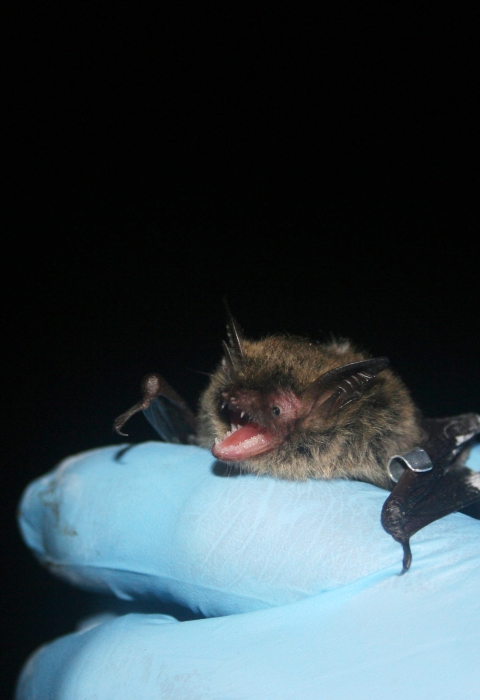In an effort to conserve the northern long-eared bat, the U.S. Fish and Wildlife Service has announced a final rule today that uses flexibilities under section 4(d) of the Endangered Species Act (ESA) to tailor protections to areas affected by white-nose syndrome during the bat’s most sensitive life stages. The rule is designed to protect the bat while minimizing regulatory requirements for landowners, land managers, government agencies and others within the species’ range.
“The overwhelming threat to the northern long-eared bat is white-nose syndrome,” said Service Director Dan Ashe. “Until there is a solution to the white-nose syndrome crisis, the outlook for this bat will not improve. This rule tailors regulatory protections in a way that makes sense and focuses protections where they will make a difference for the bat.”
The Service listed the northern long-eared bat as threatened under the ESA in April 2015 and established an interim 4(d) rule following drastic population declines caused by white-nose syndrome in the eastern and midwestern United States. This deadly disease continues to spread westward and wreak havoc on cave-dwelling bats. In November 2015, presence of the fungus that causes white-nose syndrome was confirmed in the 30th state – Nebraska.
The final 4(d) rule for the northern long-eared bat removes prohibitions that would otherwise be in place on “incidental take” of the bat in areas of the country not affected by white-nose syndrome (see map). Incidental take includes harm, harassment or mortality that occurs incidental to an otherwise lawful activity, such as clearing trees for a construction project.
In areas of the country impacted by white-nose syndrome, incidental take is prohibited if it occurs within a hibernation site for the northern long-eared bat. It is also prohibited if it results from tree removal activities within a quarter-mile of a hibernaculum or from activities that cut down or destroy known occupied maternity roost trees, or any other trees within 150 feet of that maternity roost tree, during the pup-rearing season (June 1 through July 31). Occupied roost trees may be removed when necessary to address a direct threat to human life and property. In other cases, a permit for incidental take may be needed.
Under the final rule, intentionally harming, harassing or killing the northern long-eared bat is prohibited throughout the species’ range, except for removal of northern long-eared bats from human structures, and when necessary to protect human health and safety.
Hundreds of federal, state and tribal agencies, international governments, non-profit organizations, and academic institutions have coordinated an international response to address white-nose syndrome through research, disease monitoring and management, conservation, and outreach. The U.S. has invested more than $45 million in public and private funding, and progress has been made in addressing the disease.
“We are beginning to see glimmers of hope in the battle against white-nose syndrome,” Ashe said. “In just eight years, this disease, previously unknown to science, has been identified and its cause understood. A solution could soon be within our grasp. Now is the time to get all hands on deck to pull together to fight this primary threat. Our final rule is designed to ensure we focus our energies where they will do the most good for this imperiled species while avoiding unnecessary regulation.”
Under the ESA, the Service may implement rules under section 4(d) for species listed as threatened. Such rules enable the Service to tailor the Act’s protections to those needed most to conserve the species, while reducing the regulatory burden by relaxing prohibitions where and when it fits with the species’ conservation needs.
The agency used the best available scientific and technical information, provided through more than 40,000 comments solicited during its interim 4(d) rule, to ensure it was basing this final rule on the best information available.
The Service will continue to monitor northern long-eared bat populations to ensure its threatened listing accurately reflect its status, as required by the ESA. These efforts include actively monitoring northern long-eared and other cave-dwelling bats using winter surveys of hibernation areas and conducting periodic reviews of the population to ensure its current listing status as threatened is appropriate.
As white-nose syndrome continues to affect this species, the bat’s status may decline to the point that it becomes endangered. In that event, the Service would publish a new proposal requesting public input. If the bat were to be listed as endangered in the future, the 4(d) rule would no longer apply, and all regulatory prohibitions under the ESA would take effect. This means that most intentional and incidental take throughout the range of the northern long-eared bat would be prohibited unless permitted.
In the United States, the northern long-eared bat is found from Maine to North Carolina on the Atlantic Coast, westward to eastern Oklahoma and north through the Dakotas, reaching into eastern Montana and Wyoming.
Bats are critical to our nation’s ecology and economy, eating tons of insects nightly and providing a natural benefit to farmers and foresters. Some research estimates that bats provide at least $3 billion annually in economic value.
The final rule appears in the Federal Register on January 14, 2016 and takes effect on February 16, 2016. For more information on the special rule for the northern long-eared bat, go to http://www.fws.gov/midwest/endangered/mammals/nleb/index.html. For information on white-nose syndrome, go to https://www.whitenosesyndrome.org/

